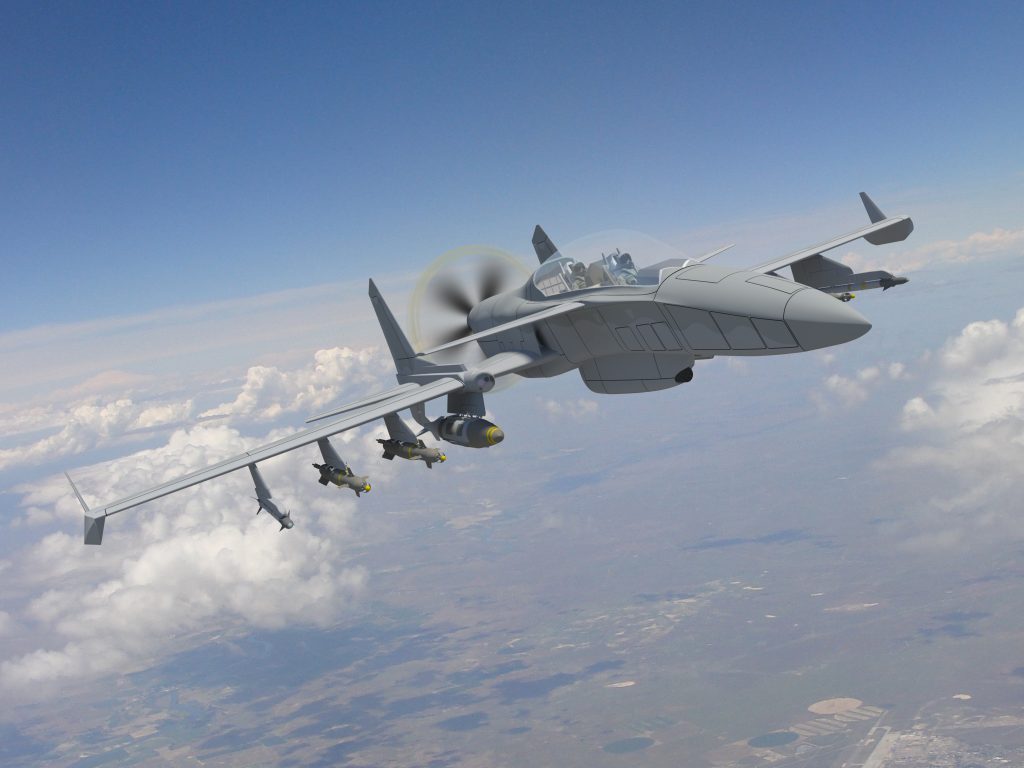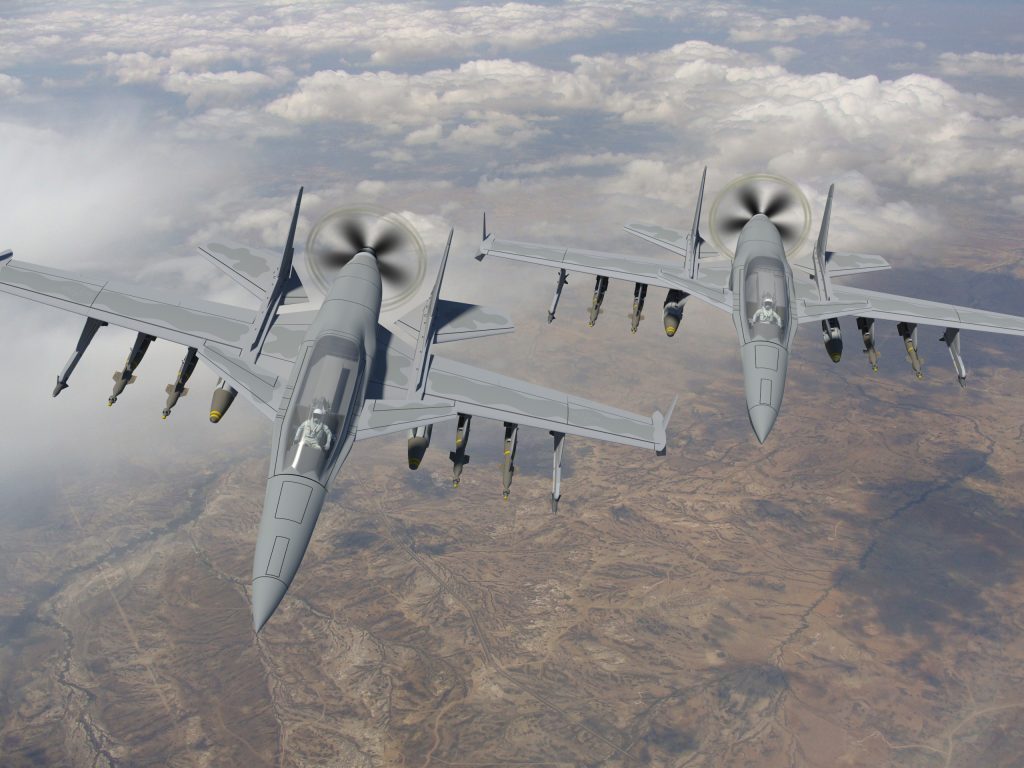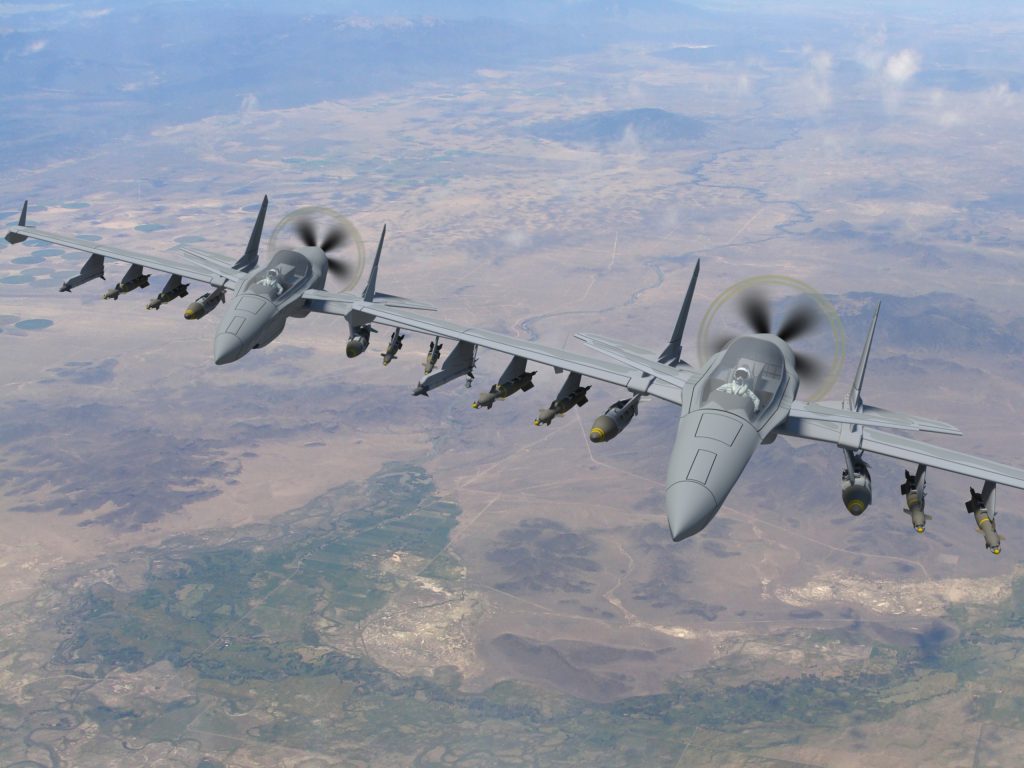STATEMENT
THE SM-27 MACHETE FOR CAS
Author: Christopher R. Beskar
Date: 6 August 2021
The Machete is a Close Air Support (CAS) aircraft. It is a ground attack aircraft conceived for High Threat CAS where the aircraft is operating within or near a Surface to Air Missile Engagement Zone (MEZ) and is threatened by anti-aircraft artillery, small arms fire, Man-Portable Surface to Air Missiles (MANPADS) and enemy fighter aircraft. The Machete is the Air Asset component in the CAS mission, but in two seat tandem configurations can also serve as its own Forward Air Control (FAC) aircraft. The Mission of CAS is to dispense lethal authority upon hostile targets that are in close proximity to friendly surface forces. According to DoD JP 3-09.3 “CAS requires (the) detailed integration of each air mission with the fire and movement of those (friendly) forces.” In satisfying a CAS mission there are three components: the Surface Commander (whose intent is considered when executing the CAS mission), the Controller (the representative of the Surface Commander who communicates directly with pilots of air assets to direct air strikes in the tactical area) and the Air Asset (the fixed or rotary wing aircraft that delivers ordnance and other lethal mechanisms to target).
The Machete is the Air Asset component of the CAS mission. The two seat tandem Machete, including the SM-27T and SM-28T, can also serve as is own Forward Air Control (FAC) aircraft by allowing a Controller who is in secure communication with the Surface Commander the ability to direct the pilot from the rear seat of the aircraft. Conceived to address a variety of real Irregular Warfare (IW) needs. The Machete enables air strikes directly at core insurgent forces in the field, in training, and in hiding. Particularly well-suited for low-level CAS, FAC and COIN above dense jungle, desert, maritime, and rugged mountain environments, Machete aircraft will exhibit exemplary maneuverability, integrated network centric sensors and electronic countermeasures, superior low-speed handling, short-field performance, high maximum level speed, significant external warload and reduced maintenance requirements. Designed to bridge A-10 capabilities while succeeding A-1 Skyraider, A-37 Dragonfly and OV-10 Bronco aircraft worldwide, the Machete is a Superior Next-Generation Close Air Support, Super-COIN and Precision Attack Aircraft.
How does the Machete deliver Superior CAS? It starts with the 30mm cannon. This weapon is extremely effective and is the primary lethal mechanism of the A-10. The Machete is equipped with either the seven barrel GAU-8/A or its four barrel lightweight derivative, the GAU-13/A located in a ventral weapons fairing. With 1,000 rounds or more of ammunition (depending upon desired external warload), the SM-27 delivers the same firepower as an A-10 resulting in an aircraft that is both a CAS platform and a tank killer. The Machete is the only other attack aircraft in the world engineered to carry either the GAU-8/A or over 1,000 rounds of ammunition allowing for significant kill capacity over a long endurance.
With a 53 ft wingspan and eight external stores stations, four of which are rated to 2,500 lbs at a load factor of 7.5g, the Machete combines its 30mm gun with significant external weapons capacity. Able to carry up to three times the warload of a Super Tucano ALX or up to 8,000 lbs of precision external weapons with full fuel (10,000 lbs with 60% maximum fuel), the Machete offers a warload that exceeds that of any production light attack aircraft.
Able to carry the same external load that the A-10 carries in over 80% of its missions, the Machete offers the weapons interface buses to carry precision smart and stand-off munitions as well as iron bombs and rockets. With a wing area greater than that of an F-16, the Machete invokes presence. Fully loaded at 30,000 lbs, the useful load of an SM-27 is 3,095 lbs greater than the maximum takeoff weight of an Embraer A-29 Super Tucano ALX. In terms of useful load, the SM-27 could carry a fully armed A-29 aloft with over 2,000 lbs of fuel and 30mm ammunition to spare.
In so doing, the Machete is in a category shared by few aircraft other than proven combat veterans. With ample wing area equipped with leading edge slats and double slotted Fowler flaps, the Machete can fly low and slow, operating at much lower airspeeds than an A-10 while offering a greater maximum level speed than an A-29 or AT-6B.
Coupled with canard foreplanes, an all moving horizontal stabilizer and twin vertical tails, the Machete has ample lifting and flight surfaces to afford a degree of supermaneuverability while ensuring that there is sufficient damage tolerance to enable the aircraft to remain airborne despite damage or loss of any one individual flight control surface. Controlled using a digital power-by-wire flight control system, not only does the Machete have distributed, damage tolerant flight controls, but the aircraft is able to automatically compensate for flight surface damage through differential deflection of undamaged control surfaces.
In terms of maneuverability, the aircraft’s wing loading varies from 50 lbs/sq ft at landing weight to 65 lbs/sq ft at clean takeoff, 71 lbs/sq ft at typical takeoff weight and nearly 85 lbs/sq ft at maximum gross weight. Lower than the A-10 yet high enough to afford a high degree of stability while flying at low levels in turbulent air, when coupled with double slotted Fowler Flaps the Machete can fly low and slow while turning tighter than most competitors.
With respect to power, the SM-27 is equipped with the proven PW150, the same engine in the highly efficient Bombardier Q400 regional airliner. Derated to 4,000 SHP and with growth potential to over 6,000 SHP, the Machete has the power where it is needed to carry greater loads, pull higher g’s in a sustained turn, to takeoff in a shorter distance and to climb at very high rates of speed. With an industry leading specific fuel consumption of 0.35 at cruise settings, with its large capacity internal fuel tank the Machete has extraordinary endurance.
All of these aspects combine to address the three key factors necessary for an effective CAS aircraft in today’s combat environment:
(1) Finding and Identifying Targets
(2) Acquiring and Killing Targets
(3) Surviving Enemy Surface to Air Defenses
This is critical as an attack aircraft must fly slow if it is to find and identify tanks as well as entrenched tactical targets. The Machete, engineered for slow flight, is that aircraft. While flying slow enough to find targets is critical, it is also essential to be able to acquire and engage targets quickly. This is where the Machete with its comprehensive sensor suite, combined with target acquisition oriented avionics and displays, digitally controlled flight surfaces and highly effective 30mm cannon and precision guided munitions shines. The Machete brings to bear the advanced sensor fusion and targeting systems of a fifth generation fighter with the low speed survivability of an A-10 gun platform.
The integration of advanced electronics is perhaps one aspect of the Machete that is overlooked. The Machete family was conceived in an age of integrated sensors and network centricity. The architectural backbone of the Machete is an integrated network warfare environment from its secure data links, to sensor processors to flat panel touch screen display systems. While the Machete’s architecture is flexible enough to allow the installation of off-the-shelf legacy avionics, the Machete may be equipped with the most advanced sensors, navigation, communication and EW suite depending upon customer desire. In so doing, the the Machete itself is an enterprise weapon system that can even operate autonomously as an non-piloted weapon platform. The role of a CAS aircraft for the High Threat environment is, however, survival. Surviving Enemy Surface-to-Air Defenses is what the Machete is about. As mentioned earlier, from a configuration standpoint, the Machete is a three surface aircraft that can fly after loss of 1/3rd of it’s flight surfaces. If the tail or canard is destroyed either may compensate for the loss of the other.
Lose of significant wing area or one vertical stabilizer will not disable the aircraft. The propeller, which is protected to some degree by twin vertical stabilizers, is a robust, titanium foam metal sandwich structure designed to absorb impact while maintaining a hardened surface that sustains a showering of FOD without tremendous degradation.
Looking directly at the Machete structure, the aircraft is composed of damage tolerant aluminum and titanium foam metal sandwich skins that are known to provide superior ballistic protection. Attached to a subframe of aluminum lithium and titanium spars, longerons, frames and bulkheads, the modular Machete is built from a structure that offers inherent armor properties. To protect the flight crew, each cockpit is built as an armored module surrounded by a composite and titanium foam metal sandwich bathtub conceptually similar to that of the A-10. With over 500 lbs of advanced flight crew specific armor the aircraft is designed to survive significant small arms fire. Atop the cockpit is a bird-strike resistant, rifle fire resistant one inch thick hybrid polycarbonate canopy that benefits from impact resistance technology developed by the AFRL.
While the Machete is designed to survive a hit, preventing a hit in the first place from surface launched guided weapons is a primary facet of the Machete advantage. The SM-27 is engineered to be equipped with organic, internal countermeasures including, comprehensive RWR, LWR, EW Jammers, standard Chaff and Flare dispensers as well as Stavatti proprietary active ballistic countermeasures. In the years to come this countermeasures suite will be expanded to include proprietary, cost plus optional directed energy self-protection systems. The Machete is an integrated Electronic Warfare platform that offers the internal volume, databuses and architecture to wield a comprehensive countermeasures suite.
Adding to mission capability of the Machete is its sensor suite. Owning a pusher configuration allows not only the Machete to be produced in both propeller and jet driven variants, but also allows the aircraft to benefit from nose mounted sensors. The Machete may be equipped with a variety of radars including the RACR AESA radar with high resolution synthetic aperture imaging, Track While Scan, Sea Surface Search, Ground Moving Target Indication and the ability to track over 20 targets while scanning. Combined with optional customized Terrain Following, the Machete may be equipped with a very capable fire control and mapping system. Non-radar equipped Machetes may feature a variety of electro-optical sensors including a EOTS nose module to accommodate a wide selection of EO sensor packages. To reduce aerodynamic penalties, Stavatti will offer exclusive streamlined fairings with linear sensor ports to incorporate EO scanning and tracking as well as laser target designation. Offering a variety of nose-mounted sensor packages, additional EOTS sensors may be mounted to the empennage support booms and wingtip fairings to provide wide area, 360° sensing.
The Machete is the proverbial Mudfighter. It gets low and slow and takes a tremendous amount of punishment to complete an unforgiving treacherous mission. Much of its life may be spent 50 to 500 feet off the ground where novel features found in no other aircraft, including survivable titanium foam metal fuel tanks, will make all the difference. The Machete combines those elements which have been demonstrated throughout the history of air warfare to result in an effective CAS platform while introducing features aircrews wish had always been there. While many aircraft can perform a CAS mission, few ever find their home there. The Machete will.





